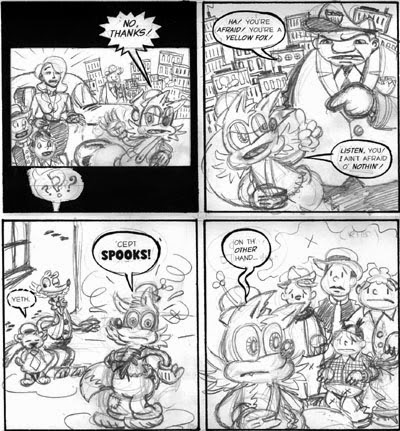All of this information is old and outdated.
It comes from the original Eddie Fox website, circa 2011 and before.
We provide it as potential entertainment and history.
How Eddie Fox Came to Be
Here is a relevent excerpt from that story:
"Eddie took his name but not his disposition from Eddie Cantor. He was a liar, a rogue, never more than a few steps ahead of the law. But he had one thing going for him: he was the Greatest Saxophone Player in the world.
"When Eddie played, notes floated like angels all over the page, spilling out into the gutters and off the paper's edge, circling the heads of the other characters, enrapturing everyone in the panel and out. He was always forgiven for his pranks; he always laughed and waved and moved on to insinuate himself on a fresh and unsuspecting town.
"In his first adventure, in 1936, he arrived penniless in a thinly disguised New York City, stiffed the cab fare, and found the name of his old girlfriend Georgia lit up in lights outside a swanky nightclub. At first the girl fox threw a fit when Eddie walked back into her life, but by the end of the story Eddie had won her back and was well on his way to starting a jazz band of his own. Over the next few issues that band took shape, with Georgia singing, Clarence the Bear on clarinet, Riff the Muskrat on drums and Toot, a depper ferret on trumpet. They played all over the world, and everywhere they went a mild intrigue always rose up around them, like dust off the road, from which only music could save them."
Obviously, lots of details have changed since then -- but perhaps I've been haunted by Eddie just like the character in the story: because here I am fifteen years later drawing comics about his "real-life" history...
How Tinsel*Town is Made
In either case, the lettering is done on the computer using P22's POP ART font. This is as good or better than any of Comicraft's popular comic book fonts, and costs a fraction of the price.
I print out the scripted letters and actually paste them onto the artwork. WARNING: This is not how real comic book letterers work! But because I write and draw at the same time, I need to see the words on the page. Also, this allows me to hand-draw the word balloons.
Once the page is laid out and scripted, pencilling can begin. Below is an episode of Tinsel Town in this early stage: the computer lettering has been glued to the page, the panel frames and word balloons have been inked, and the pencil drawings completed.
Recently I found a terrific radio station (105.5 in Central Maine) that plays nothing but vintage jazz, Big Band and vocal music. I listen to it a lot while I draw Eddie Fox -- it's the perfect accompaniment, takes me out of myself and into the half-fictional 1930's world where Eddie lives.
The page above is unusual in that I pencilled the whole thing before beginning to go over the drawing in India Ink. Frequently if I'm stumped on a panel I'll ink other panels on the page before completing the pencils. Either way, eventually I wind up with a page that has been completely rendered in heavy blank ink, like the one below...
The page is then scanned into the computer (in this case a Macintosh Quadra 660 AV), reduced in size and colored in Adobe Photoshop using a variety of techniques. Special lettering effects are sometimes added from Adobe Illustrator files. I then save two different versions of the completed, colored page: a low-resolution JPEG for the online serial, and a higher resolution TIFF to use in the PDF eComic Book. And that's it!
For more detailed descriptions of how comics are made, be sure to visit Dandy Don Simpson's Megaton Man site. His terrific Megaton Man weekly serial is what inspired us to do our own, and his drawing tips and links to comics creator's sites are not surpassed.



